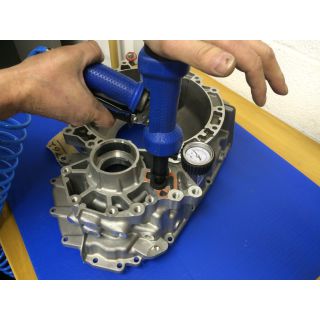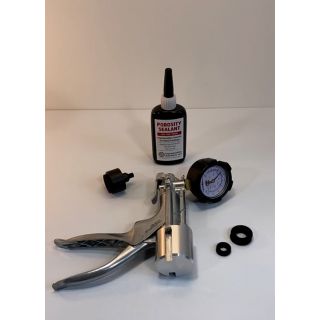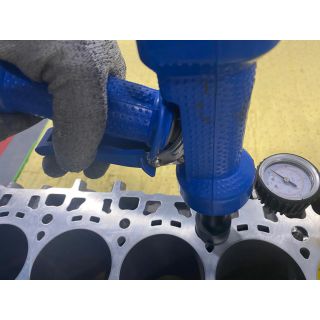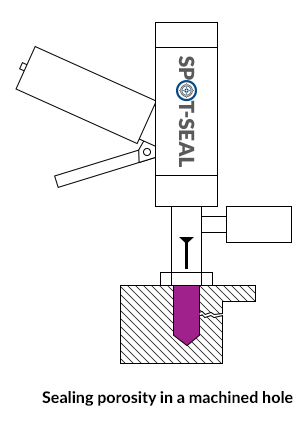Blog
POROSITY SEALING APPLICATION VIDEO BY TWEED’S GARAGE
23 October 2025
Tweed’s Garage, a well-known YouTube channel that specialises in the restoration of classic cars, motorbikes, engines and vintage machinery of all shapes and sizes has produced a video that includes the impregnation of a leaking gearbox casting for a 1937 Scott Squirrel motorcycle using our ‘ISL-15C Thin Porosity Sealant’.
https://youtu.be/d-Mvng1MERk?si=CI80EVdPvavdbuUc&t=208
SEALING POROSITY IN A 1976 TRIUMPH TRIDENT T160 MOTORCYCLE
25 September 2025
During the restoration and modification of a 1976 T160 750cc Triumph Trident Motorcycle the triple air-cooled motorcycle engine was found to be leaking through porosity between the intake ports and the valve spring seats.
One of the modifications involved increasing the air flow from the carburettors into the engine, which required opening up the inlet ports in the cylinder head. This resulted in breaking through the port wall into the oil drain grove of the spring seats that required rebuilding by TIG welding. On leak testing the welds were found to be porous and required sealing to prevent oil seeping into the inlets and affecting combustion.
The porous welds were sealed using ISL-500C Medium viscosity Porosity Sealant after consultation with Impregnation Solutions Ltd. A DIY instruction sheet was supplied to assist with applying the impregnation sealant directly to the porosity causing the leakage.
“After sealing the ports were tested and held a 500mb vacuum. Now the cylinder head ports are sealed, the oil burning problem should be fixed.” Quoted Tim Slaney, owner of this significantly improved Triumph Trident.
Full modifications to this unique and much improved Trident T160 included 34mm Mikuni RS flat slide carbs, which transformed the starting and driveability, Surflex friction clutch plate, triplex primary chain conversion kit, Neil Beadling’s 830 big bore kit with Omega forged pistons, Norman Hyde high lift cams, and a hand-made 3-1 exhaust system from Viking Exhaust.
Sealing porous leaking engine and transmission castings for performance, classic, vintage and veteran cars, motorcycles, tractors and other vehicles is a regular application for Impregnation Solutions range of DIY applied porosity sealants.
ULTIMATE TEST FOR POROSITY SEALANTS AT THE ISLE OF MAN TT RACES
06 October 2024
Report from Steve Linsdell of Flitwick Motorcycles in Bedford;
"The sealing of my Royal Enfield crankcase was a complete success.
I have not stripped the engine but it was completely leak free unlike before!
It competed in the Classic 500cc Senior race in the Isle of Man in August and we were on the podium in 3rd place so it was a good test!
The race was cut short due to abysmal weather that plagued the whole event but the bike lapped at 109.2mph from a standing start with damp patches all around the Island. It also was the fastest single cylinder Classic bike ever through the Sulby speed trap at over 144mph.
Not bad for a pushrod go to work bike!
Thanks for your help and I will recommend your product to anybody in need of sealants."
SEALING OF POROUS LEAKING CASTINGS IN CLASSIC, VINTAGE & VETERAN CARS
18 August 2024
Engines and transmissions in classic, vintage and veteran cars, motorcycles, tractors and other vehicles were often manufactured using porous castings. A consequence of casting methods of the time. Many of these castings may have leaked from the outset and were responsible for the ‘patch of oil on the garage floor’, others will have suffered corrosion over the life of the engine uncovering porosity resulting in a leak of oil, water and fuel. Some castings may have developed cracks over time and need weld repairs that will also be porous and leak. Sealing leaks in these castings can be a simple and inexpensive job and is best carried out during restoration when the engine is stripped and cleaned before re-assembly. Typical applications for casting impregnation include engine sumps, cylinder blocks, cylinder heads, water pumps and any other part that needs to contain a liquid or withstand pressure. Porosity Sealants ranging from very thin to thick viscosities can be used to seal both fine and gross casting leaks permanently.
WHY USE ‘LOCALISED’ CASTING IMPREGNATION?
16 July 2024
The vacuum impregnation of metal castings is an established process that seals porosity in engine castings and other engineering components to prevent the leakage of gases and liquids under pressure.
Carrying out vacuum impregnation often involves sending leaking castings away to a sub-contractor, Jobshop or service centre that can take days and even a week, disrupting production flow and incurring transport costs.
There is also a risk that the castings may get damaged during transport and additional handling. Processing castings through a general-purpose plant used for many different castings and metals can also result in cross contamination requiring re-work and further increased costs.
In contrast, the ‘localised’ pressure impregnation process is carried in-situ without the need to send castings away. With this process the impregnation sealant is applied directly to the spot on the casting that leaks. The process is fast and there is minimal disruption to production flow.
With a range of sealant viscosities, fine to gross leaks can be sealed.
The sealants can be applied by brush or with a pressure device.
The low sealant usage and low-cost application method provides considerable cost savings compared to vacuum impregnation equipment.
CASTING IMPREGNATION IS NO LONGER A CHEAP PROCESS - IS THERE ANOTHER WAY?
27 January 2022
Over recent years the cost of casting impregnation has increased significantly. The chemicals that make up the sealant formulations have risen sharply. The process equipment has also become more complicated and expensive with the addition of recycling, filtration and evaporation equipment in an attempt to make the process more environmentally acceptable. The result is significantly increased operating costs, which is reflected in a much higher cost per part being impregnated.
The current process involves processing baskets of castings through a line of tanks and uses large volumes of sealant, water, inhibitors and energy – required to heat cure the sealant. VOC’s are emitted into the atmosphere in the form of sealant laden vapours from the heated curing process and from the vacuum pump exhaust. The current impregnation process is neither economical or environmentally or climate friendly.
Is there another way? The current impregnation process has hardly changed since the 1970’s. This is therefore a good time to review the process and investigate other ways to seal castings.
One alternative is to look at where the casting leaks to see if sealant can be applied direct to the area of porosity. Applying the sealant direct to the porosity using pressure or heat (termed as localised impregnation) requires only a pressure gun or heat gun as opposed to a complete vacuum impregnation system, saving considerable capital investment, production floorspace and running costs.
Furthermore, tailoring the sealant viscosity to the leak rate and size of the porosity is possible with localised impregnation methods. Just because the porosity is gross (for example >200µm in diameter) doesn’t mean the casting has a structural defect and can’t be sealed, that is simply a restriction of the current process.
This is because the current vacuum impregnation process uses just one viscosity of sealant, typically 10-15cps, whereas porosity can range in size from ultra-fine to gross. Having just one viscosity limits the recovery rate as it can’t be both thin and thick at the same time.
Locally applied sealants also do not require water washing and therefore do not incur the associated costs of chemical additions and trade effluent. Only a very small amount of sealant is used and the impregnation cost per part is typically just 1/10th of the cost of using a vacuum impregnation system.
A question that is aften asked is ‘how does a locally applied sealant penetrate into porosity without using vacuum?’ The answer is in the same way that water, machine coolant, oil and dye penetrant find their way into the porosity and have to be removed before effective impregnation can be carried out. The requirement for pre-treatment to remove these contaminants before impregnation is detailed in OEM and Military specifications. It is therefore acknowledged that these liquids enter the porosity during machining and testing through friction, heat, pressure or by natural penetration.
Modern day sealants have very low viscosities and surface tensions. Combined with pressure and/or heat they will readily penetrate into porosity. Its worth remembering that vacuum/pressure impregnation plants were first designed back in the 1960’s to force phenolic and polyester resins into porosity, which were considerably thicker than modern day impregnation sealants.
Case Studies:
Customer A:
Is a major automotive engine manufacturer that has so far recovered over 2,000 engine blocks using the Spot-Seal process, producing a total saving of over £600,000 on the casting and machining value alone. The true savings are much greater when loss of production is taken into account without this solution. Vacuum impregnation equipment could not be used due to the risk of contamination, corrosion and damage to finished machined engine blocks.
Customer B:
Is a major component supplier to the automotive industry that had an issue with cast aluminium housings displaying leaks through porosity on pressure test. Due to the complexity of the housings the normal vacuum impregnation process was not suitable and therefore the localised impregnation method was investigated. External testing of housings that had been sealed using localised impregnation passed all the required tests. To date the company has sealed over 3,500 housings with a cost saving of over €840,000 using the Spot-Seal localised impregnation process.
Summary:
Localised impregnation is a very fast and inexpensive method for impregnating porosity in metal castings. The equipment is simple and a range of sealants are available to seal different sizes of porosity and leak rates from very fine to gross and even cracks. Significant cost savings are achieved by reducing sealant usage by >90% and removing the need for water washing, hot water curing and all the associated chemical and energy costs, trade effluent and VOC emissions.
Localised ‘pressure’ impregnation uses a hand-held pressure gun to push the sealant into the porosity and is ideal for sealing porosity connected to machined holes and other drillings.
Localised ‘heat’ impregnation uses a hot air gun to heat an area of porosity followed by brush or spray application of the sealant and is ideal for sealing porosity connected to an as-cast surface.
COMBINED VACUUM LEAK TEST AND PRESSURE IMPREGNATION GUN IN ONE
23 November 2020
This off the shelf gun allows the user to quickly detect leaks in castings by using vacuum, without the need for expensive leak test equipment, and then immediately apply pressure to impregnate sealant into the porosity and render the casting leak tight.
OEM automotive engine manufacturers have been using manual vacuum leak test guns to check bolt holes in automotive cylinder blocks for several years, but using the same gun to seal the leaks is a novel addition that provides significant production time and cost savings.
Leakage in castings, particularly in aluminium die-castings, is often caused by machining operations uncovering and exposing porosity in the metal that can link up to form a leak path for liquids or gases to pass. Leaks are therefore often identified in machined through holes, blind holes and threaded holes.
The vacuum/pressure gun can be supplied with a range of nozzles and rubber washers to seal leaks in different sized machined holes. The gun is also fitted with an end cap to allow the user to push down on the gun when applying pressure to impregnate the casting.
Porosity Sealants in various viscosities can also be supplied to seal a wide range of leak rates. The sealants cure in the porosity in 30 minutes at room temperature and are resistant to heat, vibration and a wide range of acids, caustics, solvents and hydrocarbons. Excess sealant can be wiped away before curing.
In addition to the automotive OEM market, the equipment and sealants can also be used by the aftermarket industry, for detecting leaks and sealing porosity in vintage and classic car and motorcycle engines and gearboxes.
NEW LOW SURFACE TENSION IMPREGNATION SEALANT PENETRATES WITHOUT VACUUM OR PRESSURE
29 September 2020
Impregnation Solutions Ltd have developed a highly penetrating sealant for the treatment of porous leaking castings. The new sealant can be applied directly to a leak area by brush or spray and naturally penetrates into the porosity (see video below).
Independent tests carried out by Birmingham University concluded the following:
“In order to be an effective sealant in metal castings the samples must display good wettability, in the form of a low contact angle, and have a low surface tension to enable penetration into the cracks. From the samples tested, which included both thermal and anaerobic curing impregnation sealants, ISL-10C was shown to be the most promising with the lowest contact angle, fastest flow rate and lowest surface tension.”
The natural penetrating ability of ISL-10C sealant removes, in many cases, the need for vacuum or pressure to achieve casting impregnation. If required, pressure can still be applied onto the sealant (for example using the Spot-Seal gun) to impregnate castings exhibiting ultra-fine porosity and very low leak rates.
In addition to the automotive OEM market for impregnation sealants, ISL-10C is also aimed at the aftermarket industry, including the sealing of leaking vintage and classic car and motorcycle engines and gearboxes. Locally heating the leak area to remove contaminants from the porosity followed by applying ISL-10C sealant will seal the pores and provide considerable time and cost savings.
Different viscosities of sealant are also available to seal the varying degrees of leak rates that occur in castings due to micro and macro porosities and shrinkage cracks. This range of sealants enables the user to achieve much higher recovery rates compared to vacuum impregnation equipment.
A MAJOR AUTOMOTIVE ENGINE MANUFACTURER APPROVES ‘SPOT-SEAL’ IMPREGNATION PROCESS TO RECOVER LEAKING CYLINDER BLOCKS BEFORE ASSEMBLY
03 February 2020
Final machining can open up porosity that is not accessible for sealing during both the casting and rough machining stages of the cylinder blocks. This results in leak test failures at the final stage of production and just before engine assembly.
This is an issue that several automotive engine manufacturers are now resolving with the Spot-Seal localised pressure impregnation process.
With final machining and assembly taking place in modern, clean and air-conditioned factories, the traditional vacuum impregnation process does not provide a practical solution due to the introduction of water, steam and chemical vapours into the working environment.
Additionally, at this stage of production, both the casting plugs and bearing caps are in place, and immersing the complete engine block in sealant risks residual hardened sealant contamination in the machined threads, oil ways and water galleries.
Apart from sealant contamination causing assembly problems and possible engine failure in the field, the additional handling of finished engine blocks through impregnation equipment can also cause damage to the machined surfaces.
Finding leaking castings at this late stage in production represents a potential significant loss in casting, machining and production time. Scrapping is a last resort, so an alternative method of impregnation is required.
The Solution
The Spot-Seal process is a localised pressure impregnation process, in that it is only applied directly to the area of the casting that leaks. In many cases this can be isolated to a machined bolt hole and therefore no other part of the casting is affected. In this particular case:
1. Sealant is applied into a bolt hole where porosity and a leak has been identified
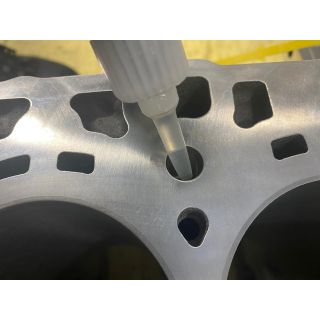
2. Pressure is applied using the Spot-Seal gun to impregnate the sealant into the porosity and stop the leak
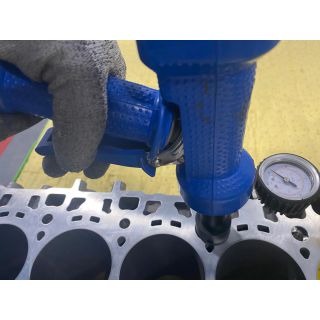
The sealant cures rapidly inside the porosity and any residual surface sealant remains liquid and is easily removed. There is no risk of contamination and damage. The process is very fast and recovery is typically 100%.
The Spot-Seal process is both manual and mobile, so can be taken to the part on the line for fast recovery and return to production or assembly. The process can also be automated for high volume applications.
The Savings
A major automotive engine manufacturer has so far recovered over 2,000 engine blocks using the Spot-Seal process, producing a total saving of over £600,000 on the casting and machining value alone. The true savings are much greater when loss of production is taken into account without this solution.
Pressure impregnation of porous leaking castings explained
29 November 2018
Sealing porous leaking castings by pressure impregnation is the same method as pressure testing but uses sealant as the media instead of compressed air or water with the benefit that the leak is not just identified but can also be sealed at the same time.
Pressure impregnation gives engineers an alternative to vacuum batch impregnation processes by being faster, achieving a higher success rate and at a lower cost per part.
Pressure impregnation is not a new process and is detailed as an approved method in US MIL-STD-276 for the Impregnation of Porous Metal Castings and Powdered Metal Components, which was first published in 1956. This standard was updated in 1992 and is still current today. Thousands of castings have been pressure impregnated and in some cases this is the only possible method that can be used, when for example the leaking casting is too large to fit into an autoclave or is in-situ, such as on an engine in a ship.
In contrast to vacuum batch processing, pressure impregnation requires identification of the leak area and the leak rate, which is also vital information for the casting manufacturer, and allows the impregnation process to be tailored by using the right viscosity of sealant and pressure to seal the porosity. Consequently a wider leak rate can be sealed. It is a single stage process and has no cold water wash or hot water curing stages, which both contribute to the loss of sealant from the porosity and a higher failure rate.
Pressure impregnation is carried out by applying the sealant directly to the area of the casting where it leaks and then applying pressure over the sealant to push it into the porosity. The process time is dependent on the size of the porosity, the type of sealant used and the level of pressure applied. For example a US-MIL-1-17563 porous test ring, which is the recognised test piece for qualifying impregnation sealants, can be fully penetrated in just a few seconds using modern day low viscosity sealants and a pressure of just 2 bar. Most castings can be sealed in under a minute. Pressure cycling can also be used to achieve penetration of the sealant into very fine porosity.
The benefits of pressure impregnation:
Fast process; castings can be impregnated in <1 minute and pressure tested after 30 minutes.
It can be a single-stage process with no need for cold water washing and hot water curing.
Requires minimal equipment and investment.
Significant cost savings due to very low consumption of sealant.
No risk of sealant contamination in machined holes, oil ways and water jackets.
Part assembled castings or in-situ castings can be impregnated without disassembly.
Contamination such as machining lubricants and dye penetrants can be purged from the porosity during pressure impregnation to ensure a high quality seal is achieved - contaminants go unseen inside the porosity but can be the cause of poor impregnation and potential failure in service.
Room temperature curing anaerobic sealants are the best option for pressure impregnation as they react with the metal, bond to the walls of the porosity and do not shrink or exude out during curing. Any surface residue can also be wiped off as the presence of air on the surface will prevent the sealant from curing.
Pressure impregnation can be carried out using a simple Impregnation Gun, which is mobile and allows the process to be taken to the part, or the process can be automated and the equipment sit alongside a leak test machine for production operation. There is no need for a water supply, connection to the drain, steam extraction, additional process chemicals or trade effluent to factor in.
Pressure Impregnation Rig
How to seal casting porosity in machined holes using localised impregnation
31 October 2018
This is a fast, effective and inexpensive way to seal porosity in machined holes and stop the leakage of gas or liquid under pressure.
Bolt holes and other machined holes in cylinder heads, blocks, cam covers, carriers, sumps and other castings are prone to leakage in the automotive OEM and supply chain business. The leaks typically occur when machining uncovers hidden porosity and connects small voids through the casting wall to produce a leak path. Unless sealed, these leaks can result in the loss of coolant and oil from the engine in service causing overheating and failure.
If the specific hole/s that leak during pressure testing can be identified then impregnation can be carried out on those holes only instead of on the entire casting, which may involve sending the parts off-site for treatment.
This process is called ‘localised pressure impregnation’ and only uses a very small amount of sealant that is applied straight into the hole. After filling the hole with sealant a compressed air gun is used to pressurise the sealant into the porosity. The application time typically takes 1 minute, after which the excess sealant is removed from the hole and any surface residue is simply wiped away. The sealant cures inside the porosity in 30 minutes at room temperature. There is no surface residue and therefore no interference with subsequent assembly or finishing operations.
The Spot-Seal casting impregnation kit includes everything that is required to carry out the localised impregnation process, including a special purpose compressed air gun, rubber washers to seal against the casting when the pressure is applied and a range of porosity sealants to seal different leak rates.
The Spot-Seal kit is mobile and can be used anywhere where there is a compressed air line supply. The localised impregnation process can also be automated for production volume applications.
Localised impregnation is far less expensive than vacuum impregnation, which involves processing the complete casting through a line of tanks and incurs high energy, chemical and water costs. However, time is the biggest saving by being able to recover a leaking casting there and then.
Even assembled or part assembled castings can be sealed using the localised impregnation process. For example, a cylinder block with the bearing caps and end plugs in place will require disassembly before vacuum impregnation can take place to eliminate the risk of cured sealant contaminating the threads, mating surfaces and water galleries. This is not required with localised impregnation as the sealant is only applied to a specific area on the casting.
This is a video showing how localised impregnation works.









